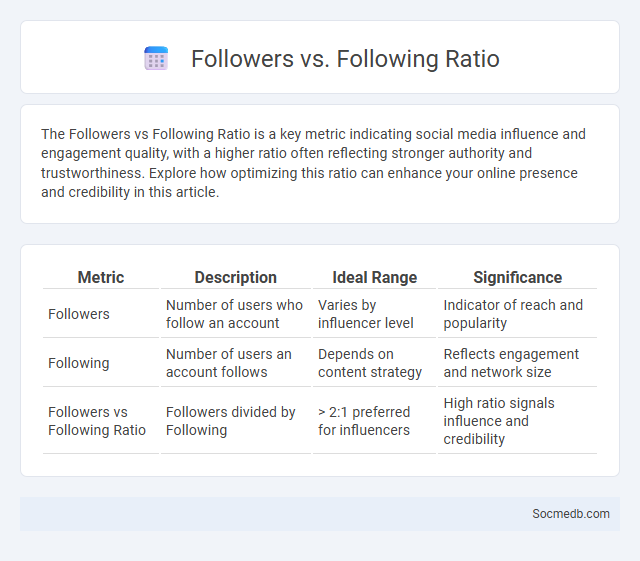
Photo illustration: Followers vs Following Ratio
The Followers vs Following Ratio is a key metric indicating social media influence and engagement quality, with a higher ratio often reflecting stronger authority and trustworthiness. Explore how optimizing this ratio can enhance your online presence and credibility in this article.
Table of Comparison
| Metric | Description | Ideal Range | Significance |
|---|---|---|---|
| Followers | Number of users who follow an account | Varies by influencer level | Indicator of reach and popularity |
| Following | Number of users an account follows | Depends on content strategy | Reflects engagement and network size |
| Followers vs Following Ratio | Followers divided by Following | > 2:1 preferred for influencers | High ratio signals influence and credibility |
Understanding Followers vs Following Ratio
Your followers-to-following ratio offers critical insight into social media influence and engagement levels. A higher ratio typically indicates authority and strong content appeal, while a balanced or lower ratio might reflect a more reciprocal and community-focused presence. Analyzing this metric helps optimize networking strategies and improve targeted audience growth.
Why Followers vs Following Ratio Matters
The followers vs following ratio on social media reflects user influence and engagement potential, where a higher ratio indicates a stronger authority and credibility within a community. Brands and influencers often use this metric to assess authenticity and the likelihood of meaningful interactions, as a disproportionate number of following accounts can suggest less genuine influence. Understanding this ratio helps optimize social media strategies by enhancing trust and attracting quality followers aligned with business or personal goals.
How to Calculate the Followers to Following Ratio
The followers to following ratio is calculated by dividing the total number of followers by the number of accounts the user is following. For example, if a social media profile has 1,000 followers and follows 500 accounts, the ratio would be 2:1. This metric helps gauge influence and engagement levels, indicating a stronger presence when the ratio is higher.
Interpreting High vs Low Ratios
High engagement ratios on social media indicate strong audience interaction, signaling effective content resonance and brand relevance. Low ratios suggest limited user interest or poor targeting, highlighting the need for content adjustment or strategy refinement. Analyzing these ratios helps businesses optimize posts, improve user experience, and drive higher conversion rates.
The Impact of Following Count on Your Profile
Your following count on social media significantly influences your profile's visibility and perceived credibility, often shaping how others engage with your content. High follower numbers can increase algorithmic favor, boosting reach and attracting more authentic interactions, while low counts may limit exposure despite content quality. Optimizing your follower growth through targeted engagement strategies enhances your social proof and overall digital influence.
Social Proof: What Your Ratio Says About You
Social proof on social media is often measured by your follower-to-following ratio, signaling credibility and influence to others. A high follower count with fewer followings typically indicates authority and trustworthiness within digital communities. Brands and individuals with favorable ratios attract more engagement, driving social validation and perceived expertise.
Strategies to Improve Your Followers/Following Ratio
Improving your followers-to-following ratio on social media requires targeted strategies such as consistently posting high-quality, engaging content that resonates with your target audience and encourages organic growth. Leveraging analytics tools to identify peak engagement times and using relevant hashtags increases visibility and attracts genuine followers interested in your niche. Building relationships through interactive features like polls, comments, and collaborations enhances follower loyalty while selectively following accounts aligned with your brand optimizes your ratio.
Common Mistakes in Managing Follow and Follower Numbers
Many social media users focus excessively on increasing follower numbers without engaging meaningfully, resulting in low interaction rates and stagnant growth. Ignoring the quality of followers and failing to analyze audience behavior can hinder your content's visibility and relevance. You should prioritize authentic engagement and analyze follower demographics to build a loyal community and improve overall account performance.
Followers vs Following: Influencer Insights
Your social media success is often measured by the Followers vs Following ratio, a key influencer insight that reflects your account's credibility and engagement potential. High follower count combined with selective following signals authority and attracts brand partnerships, while imbalanced ratios may indicate less authentic influence. Understanding this dynamic helps you strategically grow your community and strengthen your social media presence.
Best Practices for Building a Balanced Following Strategy
Developing a balanced social media following strategy requires consistent engagement with diverse audience segments and authentic content that resonates with user interests. Leveraging data analytics to identify peak interaction times and preferred content types enhances visibility and follower retention. Prioritizing quality over quantity in follower acquisition ensures meaningful connections and sustained community growth.
 socmedb.com
socmedb.com